
Sint-Truiden is a city and municipality located in the province of Limburg, Flemish Region, Belgium, and has over 41,500 inhabitants, which makes it one of the largest cities in Limburg. The municipality includes the former communes of Aalst, Brustem, Duras, Engelmanshoven, Gelinden, Gorsem, Groot-Gelmen, Halmaal, Kerkom-bij-Sint-Truiden, Melveren, Metsteren, Ordingen, Runkelen, Velm, Wilderen, and Zepperen.

Sherborne is a market town and civil parish in north west Dorset, in South West England. It is sited on the River Yeo, on the edge of the Blackmore Vale, 6 miles east of Yeovil. The parish includes the hamlets of Nether Coombe and Lower Clatcombe. The A30 road, which connects London to Penzance, runs through the town. In the 2011 census the population of Sherborne parish and the two electoral wards was 9,523. 28.7% of the population is aged 65 or older.
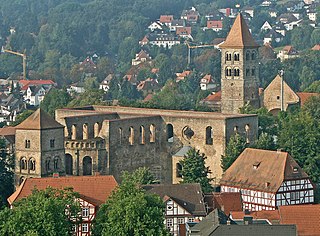
The festival and spa town of Bad Hersfeld is the district seat of the Hersfeld-Rotenburg district in northeastern Hesse, Germany, roughly 50 km southeast of Kassel.

Ramsey is a market town and civil parish in the Huntingdonshire district of Cambridgeshire, England. The town is about 9 miles (14 km) north of Huntingdon. Ramsey parish includes the settlements of Ramsey Forty Foot, Ramsey Heights, Ramsey Mereside, Ramsey Hollow and Ramsey St Mary's.

Bad Gandersheim is a town in southern Lower Saxony, Germany, located in the district of Northeim. As of December 2020, it had a population of 9,492.

Reichenau Island is an island in Lake Constance in Southern Germany. It lies almost due west of the city of Konstanz, between the Gnadensee and the Untersee, two parts of Lake Constance. With a total land surface of 4.3 km2 (1.7 sq mi) and a circumference of 11 km (6.8 mi), the island is 4.5 km (2.8 mi) long and 1.5 km (0.93 mi) wide at its greatest extent. The highest point, the Hochwart, stands some 43 m (141 ft) above the lake surface and 438.7 m (1,439 ft) above mean sea level.

Bad Dürkheim is a spa town in the Rhine-Neckar urban agglomeration, and is the seat of the Bad Dürkheim district in Rhineland-Palatinate, Germany.
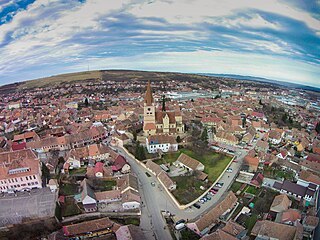
Cisnădie is a town in Sibiu County, Transylvania, central Romania, approximately 10 kilometres (6.2 mi) south of Sibiu. One village, Cisnădioara, is administered by the town.

The Fraumünster is a church in Zürich which was built on the remains of a former abbey for aristocratic women which was founded in 853 by Louis the German for his daughter Hildegard. He endowed the Benedictine convent with the lands of Zürich, Uri, and the Albis forest, and granted the convent immunity, placing it under his direct authority. Today, it belongs to the Evangelical Reformed Church of the canton of Zürich and is one of the four main churches of Zürich, the others being the Grossmünster, Prediger and St. Peter's churches.

Eberbach Abbey is a former Cistercian monastery in Eltville in the Rheingau, Germany. On account of its Romanesque and early Gothic buildings it is considered one of the most significant architectural heritage sites in Hesse.
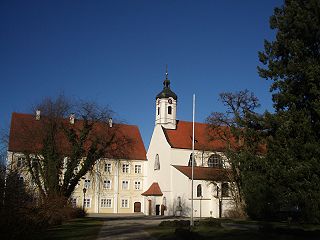
Gutenzell Abbey was a Cistercian nunnery in the municipality of Gutenzell-Hürbel in the district of Biberach, Baden-Württemberg, Germany.
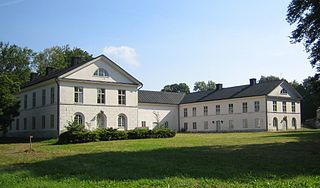
Herrevad Abbey was a Cistercian monastery near Ljungbyhed in Klippan Municipality, Scania, in the south of present-day Sweden, but formerly in Denmark until 1658. It is now a country house known as Herrevad Castle.

Lieser is an Ortsgemeinde – a municipality belonging to a Verbandsgemeinde, a kind of collective municipality – in the Bernkastel-Wittlich district in Rhineland-Palatinate, Germany.

Offenbach-Hundheim is an Ortsgemeinde – a municipality belonging to a Verbandsgemeinde, a kind of collective municipality – in the Kusel district in Rhineland-Palatinate, Germany. It belongs to the Verbandsgemeinde Lauterecken-Wolfstein.

St. George's Abbey, Isny in Isny im Allgäu in Baden-Württemberg, Germany, is a former Benedictine abbey founded in 1096 and secularised in 1802.
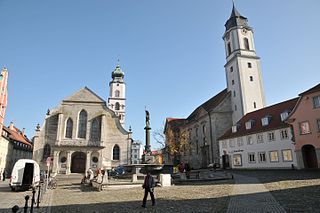
Lindau Abbey was a house of secular canonesses in Lindau on the Bodensee in Bavaria, Germany, which stands on an island in the lake.
The Middle Weser Region includes, in its fullest sense, the land along the Middle Weser between Minden and Bremen. It lies within the federal states of North Rhine-Westphalia, Lower Saxony and Bremen. However, the term is often used just to refer to the Lower Saxon part, because of the different political development of the three states and the cooperative associations formed in Lower Saxony some years ago. The Lower Saxon part of the Middle Weser Region forms the geographical heart of this state. In the centre of the Middle Weser Region are the towns of Minden, Nienburg/Weser and Verden (Aller). In the extreme north, the city of Bremen, which is not part of Lower Saxony, has a very important influence on that area of Lower Saxony surrounding it.

Malmesbury is a town and civil parish in north Wiltshire, England, which lies approximately 14 miles (23 km) west of Swindon, 25 miles (40 km) northeast of Bristol, and 9 miles (14 km) north of Chippenham. The older part of the town is on a hilltop which is almost surrounded by the upper waters of the Bristol Avon and one of its tributaries.
Count Jobst II of Hoya ruled the County of Hoya from 1511 until his death.

Arnoldstein Abbey was a Benedictine abbey in Arnoldstein in Carinthia, Austria. Its church was dedicated to St George and first mentioned in historical records in 1316 - its choir, tower, west door and a few buttresses can still be seen. The monastery buildings from the Gothic and 17th century eras were arranged around the church in an oval.























